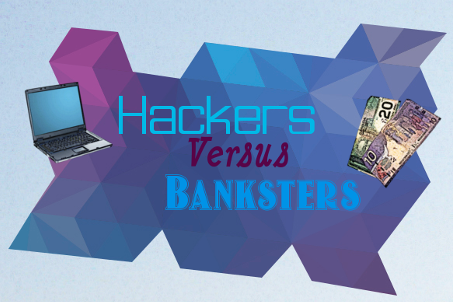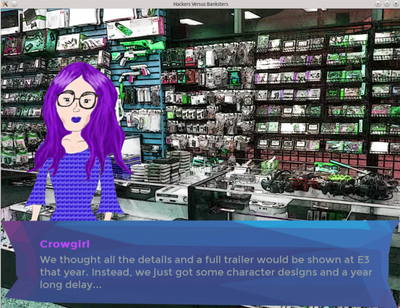Trending
Opinion: How will Project 2025 impact game developers?
The Heritage Foundation's manifesto for the possible next administration could do great harm to many, including large portions of the game development community.
In developing Hackers Versus Banksters, I took a lot of risks. How does your market react when you try something different?

Beauty is indeed in the eye of the beholder.
The Kickstarter for my game, Hackers Versus Banksters, launched very recently on March 16th. The fully playable demo has been out since March 9th.

I've been playing close attention to the feedback I've been getting so far. One thing that surprises me is the startling discrepency between the reactions of people who've only seen screenshots, and those who've actually played the demo.


Screenshot reactions:
"Your art sucks!"
"Your art has a certain charm to it..."
Demo reactions:
"This game is a lot better than I expected from the screenshots."
"I've played so many visual novels based on romance with anime-style graphics. I love how your visual novel is completely different in every way."
"The demo was actually a lot of fun! I wanna play the full version so I can try the different types of hacks."
"Your game's dialogue made me smile."
There are two things that this reminds me of.
Sushi

The first is sushi in Canada.
New York City started seeing sushi restaurants in the 1960s, but by the early 1980s, there were still few westerners eating the stuff.
The reactions to sushi from white people older than 60 today are a time capsule of how most white people felt about sushi in the 1970s and 80s.
"Raw fish? Ewww!"
Never mind that the canned tuna that's mixed with mayonnaise to put in a tuna sandwich is also raw.
But by the mid-1990s, sushi restaurants really started to flourish in Toronto! And it couldn't have possibly been only Japanese Canadians supporting them, because, by percentage of population, Japanese is a very small ethnic group in Toronto. (We have way more people who are ethnically Korean, and many more, by orders of magnitude, people who are ethnically Han Chinese.)
Sushi restaurants in Toronto started to do go business in the 90s because non-Japanese (especially white) Gen Xers were more open to trying new things than their parents were. And once they tried sushi a couple of times, they really liked it and wanted more.
But white people, especially older white people who had prejudices against eating raw fish, fish eggs, and seaweed never got to a stage of liking sushi because they refused to try it even once.
Fast forward to 2016. Toronto has many, many more sushi restaurants than we did even in the 1990s. They're in pretty much every ward of the city, hundreds of them! We have a local specialty inspired by sushi, sushi pizza. Many of the sushi restaurants on College Street and Queen Street West have maki (sushi rolls) named after Toronto and Toronto landmarks. We even have multiple restaurants that serve exclusively Kosher sushi in my very Jewish neighborhood.
Our suburbs, even the distant 905 bedroom communities such as Burlington have a number of sushi restaurants. Even some of our very small towns that are a lot less ethnically diverse than Toronto have sushi restaurants. Eating sushi is normal now.
All it took was some younger, non-Asian people to give sushi a try rather than going, "raw fish... ewwww!"
XKCD

And the second thing that the reactions to my game's screenshots remind me of is XKCD.
You've probably seen at least some XKCD comic strips online. It's undoubtedly the most popular comic strip to ever debut on the web. People often use XKCD strips in forums and social media to illustrate points about philosophy, technology, and culture. (There's even a Reddit bot that posts summaries whenever someone links to an XKCD strip.)
The creator, Randall Munroe, is about my age. His art style in XKCD is even more "amateurish" than my art style in Hackers Versus Banksters.
If I feel like the negative reactions to my art are getting me down, I can remind myself that:
Someone actually bothers to maintain a whole entire website about how they don't think XKCD is funny
Mr. Munroe is criticized for his "lazy art" all the f%*kin' time
If Munroe was like Phil Fish (developer of Fez), instead of continuing XKCD and crying all the way to the bank, he'd rage quit from the harsh comments.
Reactions to Game Art are Tied to Industry Trends
I love JRPGs. I love JRPGs so much that about 40% of the hundreds of console, PC, and mobile games I own are JRPGs. (If Korean and western games that are inspired by JRPGs are included, that figure becomes more like 45%.)
I'm 32 years old, so I got into gaming with the Commodore 64, MS-DOS, and the third generation of consoles. By the time the fifth generation of consoles debuted with the Sony PlayStation in 1995, I had already been playing video games for seven years.
I remember getting my first SNES for Christmas 1991 and being blown away by the graphics in Super Mario World. Anyone born after 1990 would look at SMW today and think "retro pixel art" in the best case scenario.
Wild Arms debuted for the PlayStation in December 1996, and Final Fantasy VII soon followed in in January 1997.

Wild Arms is actually a very good game, in my opinion. The battle scenes have very crude polygonal graphics, but everything outside of the battles and opening anime is made with pixellated sprites, characters included.
Industry analysts believe that one of the reasons why the first Wild Arms game did poorly commerically is that Final Fantasy VII launched five weeks later with fully polygonal characters. Yes, Wild Arms was also a brand new franchise and Final Fantasy was already well established, but millions of gamers likely didn't even give Wild Arms a chance because they didn't want so many pixellated sprites in a PSOne game. Fifth generation consoles were all about breathtaking 3D polygons... which were crude enough to have aged worse than the graphics in the games from the preceeding fourth generation of consoles.
I'm Standing On The Shoulders of Giants
The recent indie game renaissance that began in 2008 or so repopularized pixel art. To gamers who are my age, good pixel art conveys strongly nostalgic feelings.
Taken to the logical extreme of pixel art simplicity, there's Thomas Was Alone, which is also a game I've very much enjoyed:

Minecraft made Notch a billionaire and the game does have polygonal graphics, but very few polys with very crude pixel art-ish textures:

But Thomas Was Alone wasn't sparred from gamers who say it "sucks."
And suprisingly enough, nor was Minecraft!
"Obviously graphics are not the point here, but I really can't get past the vomit inducing graphics on my 23" Full HD monitor."
Like Mike Bithell (Thomas Was Alone), and Notch, I'm taking a huge risk by making Hackers Versus Banksters look very different from most other games. People are often hostile to styles that they're unfamilliar with.
But I don't expect to even make a tiny fraction of the money Notch has made, or even Mike Bithell. I have very modest goals of raising $753 USD ($1000 Canadian) from my Kickstarter, and being able to buy groceries with my game dev income.
Gamers complained when western AAA devs started to spit out countless Call of Duty clones. Then gamers complained about indie devs taking risks making games with quirky graphics that appeal to niche audiences. You absolutely can't please everybody.
My mood improves when people who actually played my demo tell me how much fun they had.
To new indie devs out there, I recommend that you don't get discouraged by criticism. Literally everyone gets it, no matter what they do.
Read more about:
BlogsYou May Also Like